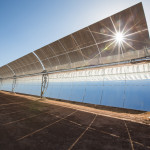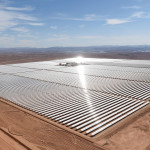
WHY THIS MATTERS IN BRIEF
Energy produced from renewable sources is finally getting its day in the sun, as more, larger renewable energy installations come online the economics of renewables keep getting better and better and the only way is up.
Cracked fields stretch away towards the Moroccan desert to the south but the barren landscape here, at the foot of the High Atlas mountains and at the northern tip of the Sahara Desert, isn’t as desolate as it once was because this area is now home to “Ouarzazate Noor” – Africas largest solar power plant. And by 2020 it will be the worlds largest solar power plant by a wide margin.
500,000 curved mirrors – each as big as a bus, are arranged in 800 rows and cover a staggering 1,400,000 sq m (15m sq ft) of desert, an area the size of 200 football fields, and they sit, nestled, on a sun blasted site that gets on average 330 days of sun each year 10km (6 miles) from Ouarzazate – the city nicknamed the “Door to the desert.”
By 2020 the plant, which cost over $3 Billion and which was partly funded by the World Bank, will be generating over 2,000Mw of energy – enough to power over 5 million homes, making it the worlds largest solar power plant by capacity, way ahead of China’s Longyangxia Dam Solar Park which generates 850Mw and Indias Kamuthi Solar Power Project which generates 648Mw.
As well as meeting domestic needs, Morocco hopes one day to expand the plant further into the desert and export solar energy to Europe and the rest of the world. This is a plant that, following on from a series of Asia-Pac announcements about creating a giant global energy “super-grid” earlier in the year, could help define Africa’s – and the world’s – energy future.
After many years of false starts, solar power is coming of age as countries in the sun finally embrace their most abundant source of clean energy, as well as realise that it could help provide them with a gleaming new future, at the heart of the energy industry. The Moroccan site is one of several across Africa and similar plants are being built in the Middle East – in Jordan, Dubai and Saudi Arabia. The falling cost of solar power has made it a viable alternative to oil even in the most oil-rich parts of the world.
Noor 1, the first phase of the Moroccan plant, has already surpassed expectations in terms of the amount of energy it has produced. It is an encouraging result in line with Morocco’s goal to reduce its fossil fuel bill by focusing on renewables while still meeting growing energy needs that are increasing by about 7% per year. Morocco’s stable government and economy has helped it secure funding, for example, the European Union contributed 60% of the cost for the Ouarzazate project.
The country plans to generate 14% of its energy from solar by 2020 and by adding other renewable sources like wind and water into the mix, it is aiming to produce 52% of its own energy by 2030. This puts Morocco more or less in line with countries like the UK, who want to generate 30% of their electricity from renewables by the end of the decade.
Noors massive reflectors work by following the Sun like a giant field of sunflowers, focusing the Sun’s energy onto a synthetic oil that flows through a network of pipes. Reaching temperatures up to 350C (662F), the hot oil is used to produce high-pressure water vapour that drives a turbine-powered generator.
“It’s the same classic process used with fossil fuels, except that we are using the Sun’s heat as the source,” says Bayed of the Moroccan Agency for Solar Energy (MASEn), and the plant keeps generating energy even after sunset, when electricity demands peak by storing some of the day’s energy in reservoirs of superhot molten salts made of sodium and potassium nitrates, which keeps production going for up to three hours. In the next phase of the plant, production will continue for up to eight hours after sunset.
As well as boosting Morocco’s power production, the Ouarzazate project is helping the local economy. Around 2,000 workers were hired during the initial two years of construction, many of them Moroccan. Roads built to provide access to the plant have also connected nearby villages, helping children get to school. Water brought in for the site has been piped beyond the complex, hooking up 33 villages to the water grid.
MASEn has also helped farmers in the area by teaching them sustainable practices but even so, some locals have concerns. Abdellatif, who lives in the city of Zagora about 75 miles (120 kilometres) further south, where there are high rates of unemployment, thinks that the plant should focus on creating permanent jobs. He has friends who were hired to work there but they were only on contract for a few months. Once fully operational, the station will only require about 50 to 100 employees so even though the plant will keep the money flowing in the job boom may end.
“The components of the plant are manufactured abroad but it would be better to produce them locally to generate ongoing work for residents,” he says.
A bigger issue is that the solar plant draws a massive amount of water for cleaning and cooling from the local El Mansour Eddahbi dam. In recent years, water scarcity has been a problem in the semi-desert region and there are water cuts. Agricultural land further south in the Draa valley depends on water from the dam, which is occasionally released into the otherwise-dry river. But Mustapha Sellam, the site manager, claims that the water used by the complex amounts to 0.5% of the dam’s supply, which is negligible compared to its capacity.
Still, the plant’s consumption is enough to make a difference to struggling farmers. So the plant is making improvements to reduce the amount of water it uses. Instead of relying on water to clean the mirrors, pressurised air is used. And whereas Noor 1 uses water to cool the steam produced by the generators, so that it can be turned back into water and reused to produce more electricity, a dry cooling system that uses air will be installed.
These new sections of the plant are currently being built. Noor 2 will be similar to the first phase, but Noor 3 will experiment with a different design. Instead of ranks of mirrors it will capture and store the Sun’s energy with a single large tower, which is thought to be more efficient.
Seven thousand flat mirrors surrounding the tower will all track and reflect the Sun’s rays towards a receiver at the top, requiring much less space than existing arrangement of mirrors. Molten salts filling the interior of the tower will capture and store heat directly, doing away with the need for hot oil.
Similar systems are already used in South Africa, Spain and a few sites in the US, such as California’s Mojave desert and Nevada. But at 86ft (26m) tall, Ouarzazate’s recently erected structure is the highest of its kind in the world.
Meanwhile other plants in Morocco are already underway. Next year construction will begin at two sites in the south-west, near Laayoune and Boujdour, with plants near Tata and Midelt to follow.
The success of these plants in Morocco, as well as in South Africa, may encourage other African countries to turn to solar power. South Africa is already one of the world’s top 10 producers of solar power and Rwanda is home to east Africa’s first solar plant, which opened in 2014. Large plants are already being planned for Ghana and Uganda.
Africa’s sunshine could eventually make the continent a supplier of energy to the rest of the world. Sellam has high hopes for Noor.
“Our main goal is to become energy-independent but if one day we are producing a surplus we could supply other countries too,” he says. Imagine recharging your electric car in Berlin with electricity produced in Morocco.
It’s not as far off as you might think – and who knows, maybe one day even Elon Musk will show up on their doorstep with new plans for another Gigafactory in his bid to ween the entire world off of fossil fuels.






















[…] solar power plant online – a fleeting record it’ll loose in 2020 when Morocco’s Ouarzazate Noor cranks up to full […]
[…] India and the US are bringing huge amounts of new solar capacity, such as the massive African Ouarzazate Noor plant online, Google, who recently achieved their own renewable energy goals, is coming to the […]
[…] record for the largest solar power plant keeps changing hands,. One minute it’s Africa, the next it’s India and now Australia wants to lay claim to it. As the price of solar […]